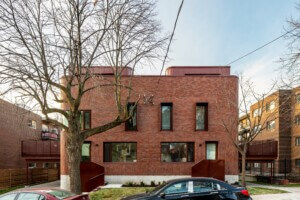The director of the Canadian Centre for Architecture for the past 14 years, Mirko Zardini, will step down at the end of the year, and Giovanna Borasi will take his place starting in January. Borasi is chief curator at the CCA, and she has been a curator at the Montreal-based institution since 2005.
Zardini led the CCA through a crucial period of growth and change. The CCA was founded in 1979 by the architect Phyllis Lambert with a desire to provoke—a masthead on their website quotes Lambert as saying “We’re not a museum that puts things out and says, ‘This is architecture.’ We try to make people think.” As its director, Zardini made crucial moves to fulfill Lambert’s mission, including the ambitious use of the CCA’s archives and exhibition spaces, enabling a vibrant research program, and launching an online platform that makes the CCA’s resources widely available. Donations to the archives during Zardini’s tenure include those of Kenneth Frampton, Pierre Jeanneret, Abalos Herreros, Cornelia Hahn Oberlander, Alessandro Poli, Umberto Riva, Álvaro Siza Vieira, and Anthony Vidler. Donations of works by architects included Zaha Hadid, Greg Lynn, Foreign Office Architects, and UnStudio. Recent exhibitions such as The Other Architect (2015-16) and three shows in the Archaeology of the Digital series (2013-16) have been international in scope and focused on challenging models of architectural practice. Zardini has positioned the CCA as a crucial node in conversations about architecture and the urban realm.
In an interview with AN, Zardini deflected questions about the “highlights” of his time at the CCA: “I like to think of what we produce as critical tools,” he said, not singular exhibitions or publications. He emphasized the CCA’s success in focusing on environmental issues, the effects of increasing global multicultural processes, the question of combining large-scale planning with button-up building, and reflections on technology. Zardini said that he hopes the CCA “will not be judged for any single exhibition or publication, but for the discourse it has produced through the years.” He added that he likes that the CCA is “mature enough as an institution to speak in a collective voice.” This is “not easy,” he says, because “as an institution, you have to build your own public.” He concluded that his achievement as a director has been in “the kind of friction we have created at the CCA – we have maintained the institution in a critical position.”
The appointment of Borasi is based on a conviction that Zardini’s time as director was a success. In a statement, CCA Board Chair and Toronto-based architect Bruce Kuwabara emphasized that the CCA will continue to build on its current direction. Borasi was involved from the beginning of when Zardini became director, and indeed before. After curating and collaborating on exhibitions in Milan and working as an editor of Lotus International, Borasi worked closely with Zardini on exhibitions in Italy and then at the CCA. They seem to think alike. One of Borasi’s current projects involves the creation of three short documentary films, the first of which, What it takes to Make a Home, will focus on homelessness. It will premier at the Architecture and Design Film Festival in New York in October 2019. This type of experimentation with media, modes of discourse, and challenging topics related to the built environment embodies the essence of the CCA’s approach to architecture.

Featuring Alexander Hagner and Michael Maltzan (Courtesy CCA 2019)
Speaking about her upcoming directorship and Zardini, Borasi said in an interview that she “shares his vision. He pushed the idea from Phyllis that architecture is not just about building, but about ideas.” Borasi emphasized their shared belief that architecture “needs to have an impact at large” by constantly asking “What are the issues that architects should discuss today?” She said that it is the responsibility of an institution such as the CCA to “ask the questions that no one wants to ask. This means that the CCA “is not neutral. Architecture that is committed, not self-referential, is the architecture I am interested in.”
Zardini was quick to emphasize how he has benefitted from collaboration at the CCA. Lambert’s support has been crucial, he said, as has collaboration with Borasi. He mentioned the help of several others at the CCA and outside, including strong advice from Peter Eisenman that the CCA should be proactive and take risks in the use of its resources. Pressed to offer advice, Zardini opined that “many other institutions are too confident of the traditional role that they have. In this moment, rather than being reassuring, institutions need to be provocative;” they should become “public intellectual figures.” Zardini spoke against the pressures of the current neoliberal moment: “Rather than thinking of architects as part of large corporations, I would rather think of architects operating with a more community-oriented strategy or in public organizations.”
Asked what he will do next, Zardini mentioned that he has “never had a chance to take a sabbatical.” He said that he “never aspired to become ‘director’ of anything,” that he is “not a director by career,” and he even mentioned wryly that did not apply for the directorship of the CCA, but was persuaded to take it by Lambert. Zardini plans to spend time in Europe and begin work on new research – to “create a new baggage of ideas to work with in the future.” Among his last projects at the CCA will be a publication of essays from the past 15 years, which is due out in spring 2020.
What will remain to be seen is whether Zardini’s departure and Borasi’s appointment will mark the end of an era for the CCA or the continuation of an approach that seems to have worked.











